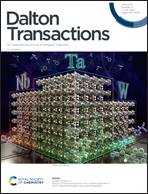Revisiting Mg solubility in CuO nanorods: limit probed by neutron diffraction and effect on the particle toxicity towards bacteria in water†
Abstract
Both nanometer-sized CuO and MgO particles exhibit bactericidal activities against Staphylococcus aureus and Escherichia coli, two bacteria causing healthcare-associated infections. The solid solution Cu1−xMgxO is potentially interesting for biomedical applications as one of the compositions could have a much higher bactericidal activity than the parent CuO and MgO oxides considered separately. But, to date, no Vegard's law proves the real existence of such a solid solution. This study was aimed at shedding light on the solubility of Mg2+ ions in CuO nanoparticles and its impact on the free oxygen radicals they produce, the quantity of which determines their bactericidal performance. The solid solution Cu1−xMgxO does exist and particles were synthesized as nanorods of 50–60 nm length by thermally decomposing at 400 °C the single source precursors Cu1−xMgx(OH)2. Vegard's laws exist only in the compositional range 0 ≤ x ≤ 0.1, due to the low capacity of the distorted NaCl-type structure to accommodate regular coordination [MgO6] octahedra. Only neutron diffraction allowed the detection of the small amount of MgO nanoparticles present as impurity in a 10 g sample beyond the solubility limit of x = 0.1. In this series, CuO nanorods remain the most active against E. coli and S. aureus with reduction in viability of 99.998% and 98.7% after 180 min in water, respectively. Our synthesis route has significantly increased the activity of pure CuO nanoparticles beyond the values reported so far, especially against E. coli. The bactericidal performances of CuO and the magnesium-substituted counterparts (i.e. Cu1−xMgxO) are not linked to cupric ions they release in water since their mass concentrations after 180 min are much lower than minimal concentrations inhibiting the growth of E. coli and S. aureus. These CuO nanorods kill bacteria in water because they produce a large quantity of free oxygen radicals in the presence of H2O2 only, the majority of which are highly toxic HO˙ radicals. Mg2+ ions have a detrimental effect on this production, thus explaining the lowest bactericidal performance of Cu1−xMgxO nanorods. Definitive knowledge of the toxicity of Cu1−xMgxO nanoparticles towards bacteria in water is now available.



 Please wait while we load your content...
Please wait while we load your content...